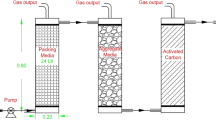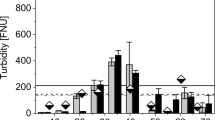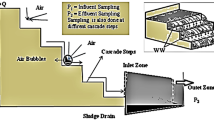Abstract
Evaluating the performance of a biotrickling filter for the treatment of wastewaters produced by a company manufacturing beer was the aim of this study. A pilot scale trickling filter filled with gravel was used as the experimental biofilter. Pilot scale plant experiments were made to evaluate the performance of the trickling filter aerobic and anaerobic biofilm systems for removal of chemical oxygen demand (COD) and nutrients from synthetic brewery wastewater. Performance evaluation data of the trickling filter were generated under different experimental conditions. The trickling filter had an average efficiency of (86.81±6.95)% as the hydraulic loading rate increased from 4.0 to 6.4 m3/(m2·d). Various COD concentrations were used to adjust organic loading rates from 1.5 to 4.5 kg COD/(m3·d). An average COD removal efficiency of (85.10±6.40)% was achieved in all wastewater concentrations at a hydraulic loading of 6.4 m3/(m2·d). The results lead to a design organic load of 1.5 kg COD/(m3·d) to reach an effluent COD in the range of 50–120 mg/L. As can be concluded from the results of this study, organic substances in brewery wastewater can be handled in a cost-effective and environmentally friendly manner using the gravel-filled trickling filter.
Similar content being viewed by others
References
Alonso, C., Suidan, M.T., Sorial, G.A., Smith, F.L., Biswas, P., Smith, P.J., Brenner, R.C., 1997. Gas treatment in trickle-bed biofilters: biomass, how much is enough? Biotechnol. Bioeng., 54(6):583–594.
Al-Rekabi, W.S., He, Q., Qiang, W.W., 2007. Improvments in wastewater treatment technologies. Pak. J. Nutr., 6(2): 104–110.
Boeije, G., 1996. New Developments in Measuring and Modeling the Removal of Chemicals in Wastewater Treatment Systems: Continious Activated Sludge Tests with Nutrients Removal (CAS-NR). Report for Procter & Gambel. European Technical Center, Laboratory of General and Applied Microbial Ecology, Gent, Belgium.
Crites, R., Tchobanoglous, G., 1998. Chapter 7: Biological Treatment and Nutrient Removal. In: Kane, K.T., Munson, E., Haag, G., Tchobanoglous, G. (Eds.), Small and Decentralized Wastewater Management Systems. WCB McGraw Hill, USA, p.397–526.
Driessen, W., Vereijken, T., 2003. Recent Developments in Biological Treatment of Brewery Effluent. The Institute and Association of Brewing Convention, Living Stone, Zambia.
Henry, J.G., Prasad, D., 2000. Anaerobic treatment of landfill leachate by sulfate reduction. Water Sci. Technol., 41(3): 239–245.
Huei, L.C., 2005. Biodegradation of Brewery Effluent Using Packed-Bed Upflow Anaerobic Reactor (PBUAR) and Membrane Bioreactor (MBR). Bachelor Thesis, Faculty of Civil Engineering, Universiti Teknologi Malaysia.
IFC (International Finance Corporation), 2007. Environmental, Health, and Safety Guidelines for Breweries. World Bank Group.
Leta, S., 2004. Developing and Optimizing Processes for Biological Nitrogen Removal from Tannery Wastewater in Ethiopia. Ph.D Theses, Department of Biotechnology, Royal Institute of Technology, Stockholm, Sweden.
Metcalf & Eddy, 1991a. Chapter 8-Biological Unit Processes. In: Clark, B.J., Morriss, J.M. (Eds.), Wastewater Engineering, Treatment, Disposal and Reuse, 3rd Ed. McGraw-Hill, New York, p.359–444.
Metcalf & Eddy, 1991b. Chapter 11-Advanced Wastewater Treatment. In: Clark, B.J., Morriss, J.M. (Eds.), Wastewater Engineering, Treatment, Disposal and Reuse, 3rd Ed. McGraw-Hill, New York, p.663–764.
Parawira, W., Kudita, I., Nyandoroh, M.G., Zvauya, R., 2005. A study of industrial anaerobic treatment of opaque beer brewery wastewater in a tropical climate using a full-scale UASB reactor seeded with activated sludge. Process Biochem., 40(2):593–599. [doi:10.1016/j.procbio.2004.01.036]
Rajaram, T., Ashutosh, D., 2008. Water pollution by industrial effluents in India: discharge scenarios and case for participatory ecosystem specific local regulation. Futures, 40(1):56–69. [doi:10.1016/j.futures.2007.06.002]
Rittman, B.E., Whiteman, R., 1994. Bioaugmentation: a coming of age. Biotechnology, 1:12–16.
The Breweries of Europe, 2002. Guidance Note for Establishing BAT in the Brewing Industry. Brewers of Europe, Brussels.
van der Bruggen, A., Braeken, L., 2006. The challenge of zero discharge: from water balance to regeneration. Desalination, 188(1–3):177–183. [doi:10.1016/j.desal.2005.04.115]
Weber, F.J., Hartmans, S., 1995. Prevention of clogging in a biological trickle-bed reactor removing toluene from contaminated air. Biotechenol. Bioeng., 50(1):91–97. [doi:10.1002/(SICI)1097-0290(19960405)50:1<91::AID-BI T10>3.0.CO;2-A]
Youcai, Z., Hua, L., Jun, W., Guowei, G., 2002. Treatment of leachate by aged-refuse-based biofilter. J. Environ. Eng., 128(7):662–668.
Yu, H., Gu, G., 1996. Biomethanation of brewery wastewater using an anaerobic upflow blanket filter. J. Cleaner Prod., 4(3–4):219–223. [doi:10.1016/S0959-6526(96)00036-4]
Zhang, L.H., Meng, X.L., Wang, Y., Liu, L.D., 2009. Performance of biotrickling filters for hydrogen sulfide removal under starvation and shock loads conditions. J. Zhejiang Univ.-Sci. B (Biomed. & Biotechnol.), 10(8): 595–601. [doi:10.1631/jzus.B0920064]
Zhao, Y., 1999. Handbook for Landfill Management. Chemical Industry Press, Beijing, p.10–198 (in Chinese).
Zhao, Y., 2001. Guidelines for Landfill Operation. Chemical Industry Press, Beijing, p.80–180 (in Chinese).
Zhao, Y., Liu, J., Huang, R., Gu, G., 2000. Long term monitoring and prediction for leachate concentrations in Shanghai Refuse Landfill. Water Air Soil Pollut., 122(3–4):281–297.
Zurchin, J.P., Olthof, M., Schubert, J.J., Peck, D., Penrose, J., 1986. Pilot Study of Upgrading of Existing Coke-Oven Waste Treatment Facility with Trickling Filter. 41st Industrial Waste Conference. Lewis Publishers Inc., Perdue, p.586–596.
Author information
Authors and Affiliations
Corresponding author
Additional information
Project (No. 7117130553459) supported by the Landeszentralkasse M-V Stipendium, Germany
Rights and permissions
About this article
Cite this article
Habte Lemji, H., Eckstädt, H. A pilot scale trickling filter with pebble gravel as media and its performance to remove chemical oxygen demand from synthetic brewery wastewater. J. Zhejiang Univ. Sci. B 14, 924–933 (2013). https://doi.org/10.1631/jzus.B1300057
Received:
Accepted:
Published:
Issue Date:
DOI: https://doi.org/10.1631/jzus.B1300057
Key words
- Biodegradation
- Pilot scale trickling filter
- Aerobic treatment
- Brewery wastewater
- Chemical oxygen demand (COD)
- Trickling filter performance




